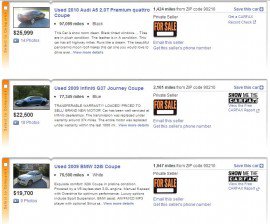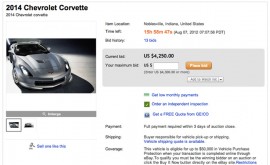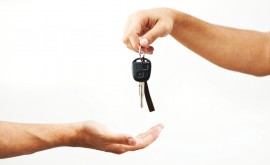There are a number of options out there to help you sell your car, turning a usually frustrating experience into something far more manageable.
I know there are two main ways to sell my junk car. One option is considerably easier and quicker but will likely get me less money for my car. The other route is much longer and requires more work, although the payout is likely worth the extra time.
The Easy Route:
Experts from HospitalCars.ca – Carleton Place & District Memorial Hospital Foundation Car Donation Program state that if you’re looking to get rid of your car and get quick cash, the first stop you should make is at a used car dealership.
Take CarMax for example, a national chain of used car dealerships with over 140 locations across the U.S.
It’s a pretty painless process at any used car dealership: you schedule an appointment and they appraise your car. It usually takes about 30 minutes and can involve a test-drive, pre-purchase inspection, collection of repair history and a comparison of your car against current market conditions like national sales trends and auction data
From there, the dealership will give you a written offer. They may have a time-condition on that offer, for example, CarMax’s offer will be good for only seven days, although the sale itself can take a little as 20 minutes and will get you some money in no time. It is also worth mentioning, that in some cases, selling your car to a used car dealership will likely not net you as much money as a private sale but it’s usually far less of a headache compared to dealing with tire-kickers and cheap-skates.
The Harder Route:

“Trust is at the core of everything we do at eBay Motors: buyers and sellers are rated, we provide free vehicle inspection reports, and our Vehicle Protection Program (VPP) is unique in the industry and protects you against fraud,” says Bryan Murphy, General Manager at eBay Motors, North America.
These sites are also a great way to see the sales trends of the used car market. You can also see how much similar cars are being sold for at local auctions. Sites like Kelly Blue Book can also provide insight into the value of your car.
Another place you can list your car is in the local newspaper’s classifieds section, although this costs more than online listings but make sure it has all the necessary verfications (read about it here). Additionally, post your car on a related forum or message board. If your car has an enthusiastic community (like say, a Civic), then a forum posting can really help your car get some additional attention.
SEE ALSO: List of Car Specific Forums

It also helps to build trust with your potential buyers. “Top sellers communicate with prospective buyers throughout the entire process to pre-empt problems, up-sell and build buyer trust,” says Niemiec
After setting up an online listing, buyers browsing these websites can then contact you or ask more questions and eventually set up an appointment to see and test the car in person.
Getting Ready to Sell
Now that your car is listed, you need to get the documents required for selling it in your state. Although you can check the DMV for the specific forms and documents, you’ll likely need items like the title information, proof of ownership, odometer readings, smog certificate, safety inspection and transfer of ownership forms for when the car is sold.
If you have it, it’s also good to show records of past work done to the car including anything done under a technical service bulletin or recalls. Prospective buyers will want to learn as much as they can about the car you’re selling so having all this information handy will make you look informed, responsible and trustworthy, a useful trait when it comes to private sales.
Finally, be sure to clean the car inside and out. Buyers won’t want to check out a dirty looking car or even sit in one that looks like it has been used by a slob or abused.
Now you can start taking calls from people who are interested in buying your vehicle.
Meeting a Buyer
Prospective buyers will likely want to set up a meeting and test drive. A good idea is to do this away from your house but in a public place, like a parking lot or community center. Always tell someone where you’re planning to be and when, just in case anything drastic happens. If you’re uncomfortable meeting strangers, consider bringing someone along.
Being polite and accommodating is a good idea but don’t let the prospective buyer dictate the meeting. Always be in control of the situation, fire up the car as they request, show what features the car is equipped with and how they work and provide maintenance information to the best of your ability.
When a test drive is in order, be sure to check that the buyer has a valid driver’s license. Always be in the car during the test drive and try to answer any questions that the buyer may have. If you know the area well, offer directions for the driver so they aren’t just wandering around and getting lost.
Negotiating and Other Prices

Some buyers may want to get a third-party mechanic to inspect the car. They should pay to have that done.
When an agreement is reached, be sure to advise the buyer that the car is being sold as-is with no warranty. When it comes to accepting a payment, be wary of personal cheques. Only take cash or a certified check.
The DMV will have a bill of sale form that includes the names, addresses and signatures of both the buyer and seller. Additionally, the form includes vehicle information, including the make, model, year and vehicle identification number (VIN). Finally the bill of sale form needs to include the date of sale and price paid.
Following the bill of sale, file a release of liability in order to protect yourself in the event the buyer keeps the vehicle titled and registered under your name. It’s now the buyer’s responsibility to get the car titled and registered under their name.
Thanks to the number of online services available and the convenience of used car dealerships, selling a car isn’t too difficult but make sure you’re prepared to answer a never-ending line of questions. Gather all the appropriate documents and get all the background information of your vehicle. It also always helps to be polite and professional with anyone who inquires.








